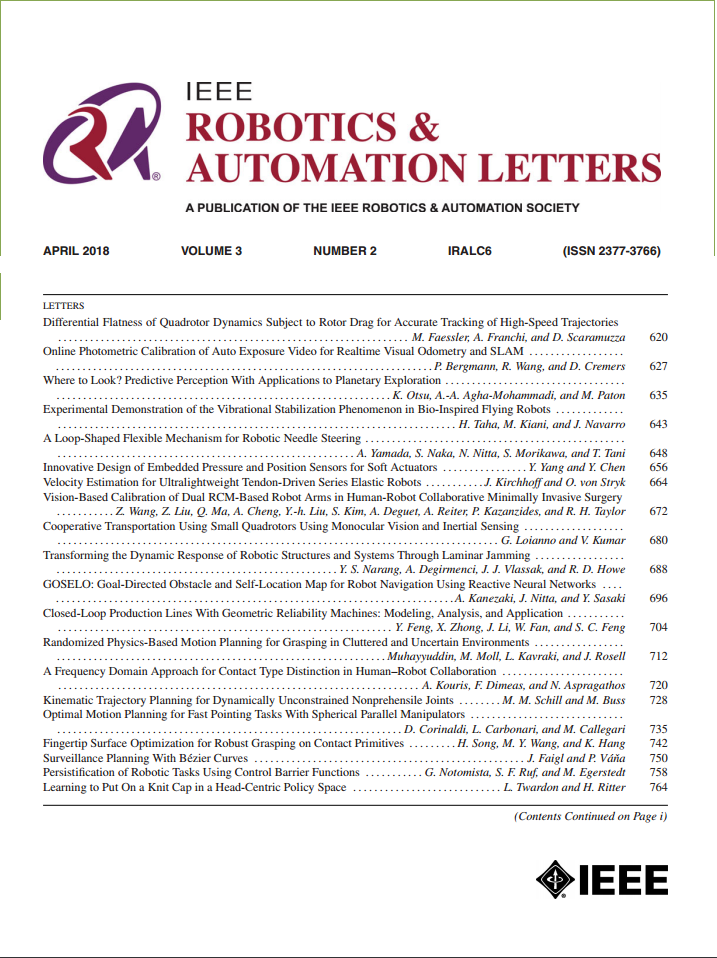基于数据驱动的步态估计的踝关节外骨骼控制,用于行走、跑步和倾斜
IF 4.6
2区 计算机科学
Q2 ROBOTICS
引用次数: 0
摘要
踝关节外骨骼具有增强机动性的潜力,但控制策略在很大程度上未能无缝地适应运动任务的变化。在这里,我们引入了一个多头网络来预测步态速度、地面倾斜度、姿态/摇摆转换和姿态百分比。这些预测被映射到外骨骼扭矩使用典型的生物扭矩作为指导。该模型训练了9名受试者在不同的速度和坡度下步行/慢跑12分钟。该控制器在4个对象上进行了验证,在训练集分布内外的速度和倾斜度范围内,姿态相位预测误差为3.4%。另一项分析显示,仅用10%的收集数据就可以获得类似的准确性,这表明,如果数据在用户和任务之间足够多样化,研究人员可能需要更少的训练数据总量。与不戴外骨骼相比,跑步时的代谢成本有所提高,但与不戴外骨骼相比,只有一名受试者在水平行走和斜坡上升时受益。总的来说,我们的控制器平滑地适应了随时间变化的倾斜和步行/慢跑速度,并通过减少的训练数据集实现了高精度,尽管可能需要更大的扭矩值才能看到代谢益处。本文章由计算机程序翻译,如有差异,请以英文原文为准。
Ankle Exoskeleton Control via Data-Driven Gait Estimation for Walking, Running, and Inclines
Ankle exoskeletons have the potential to augment mobility, but control strategies have largely failed to seamlessly adapt to changes in the locomotion task. Here, we introduce a multi-headed network that predicts gait speed, ground incline, stance/swing transitions, and percent stance. These predictions are mapped to exoskeleton torque using typical biological torques as a guide. The model was trained on 9 subjects walking/jogging for 12 minutes across a range of speeds and inclines. The controller was validated on 4 subjects, and achieved stance phase prediction error of 3.4% across a range of speeds and inclines, both inside and outside the training set distribution. A secondary analysis showed similar accuracy could have been obtained with only 10% of the collected data, suggesting researchers may need fewer total strides of training data, provided the data is sufficiently diverse across users and tasks. Metabolic cost was improved during running compared to wearing the exoskeleton powered off, but was beneficial for only one subject during level walking and ramp ascent when compared to no exoskeleton. Overall, our controller smoothly adapted to time-varying inclines and walking/jogging speeds, and achieved high accuracy with a reduced training dataset, though larger torque magnitudes may be required to see metabolic benefit.
求助全文
通过发布文献求助,成功后即可免费获取论文全文。
去求助
来源期刊

IEEE Robotics and Automation Letters
Computer Science-Computer Science Applications
CiteScore
9.60
自引率
15.40%
发文量
1428
期刊介绍:
The scope of this journal is to publish peer-reviewed articles that provide a timely and concise account of innovative research ideas and application results, reporting significant theoretical findings and application case studies in areas of robotics and automation.
 求助内容:
求助内容: 应助结果提醒方式:
应助结果提醒方式:


